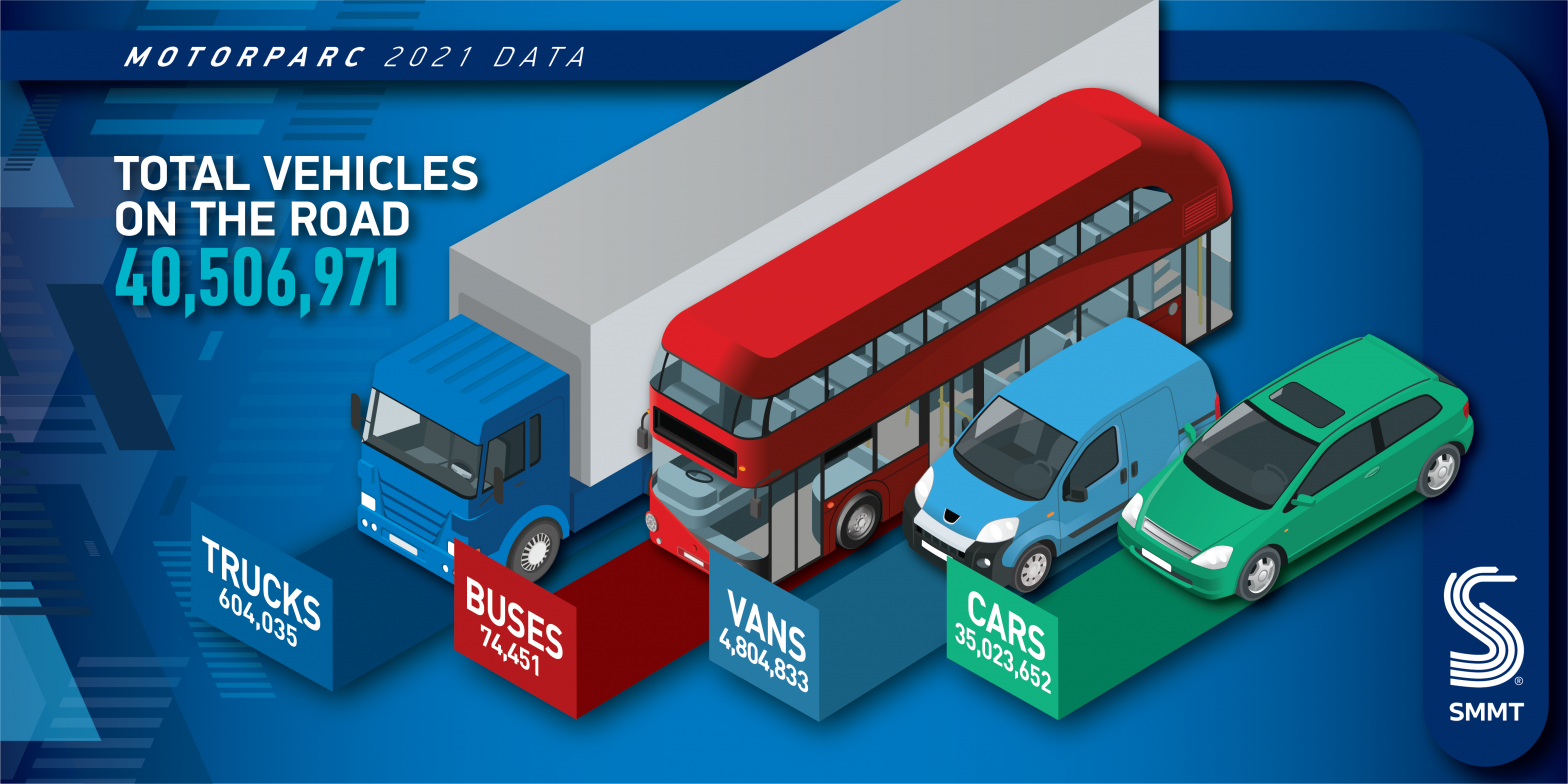- Vans, trucks, buses and coaches reach highest-ever proportion of vehicles on the road, with commercial vehicles accounting for more than one in eight vehicles in service.
- All vehicle sectors see increased numbers during 2021 as buses grow for first time since 2011.
- Electric vehicle use reaches record high but accounts for just one in 180 vans and one in 2,000 HGVs.
The number of commercial vehicles on Britain’s roads has reached the highest level in history, according to the latest annual Motorparc data, published by the Society of Motor Manufacturers and Traders (SMMT). Some 5,483,319 vans, trucks, buses and coaches were recorded in operation at the end of 2021, a 4.1% increase on the previous year.1
Working vehicles now comprise 13.5% of the 40,506,971-strong national fleet following a bumper year for van registrations and a return to growth for trucks and buses.
Vans remain the most popular class of commercial vehicle in operation, comprising 4,804,833 units, up 4.3% from 2020.2 The segment has enjoyed continuous growth since 2010 but fleet renewal has slowed. The average van on UK roads is now a record 8.7 years old, although there are significant regional variations. The youngest vans can be found in the North East, averaging 7.1 years old, while Wales is home to the oldest, with the average van dating back to 2011. While these vehicles are essential for keeping Britain’s economy on the move, renewing them with the latest low and zero emission models will be crucial if we are to deliver the country’s green goals.
HGV numbers returned to growth after last year’s fall, increasing 2.5% to 604,035 units. This was driven by significant growth in new registrations (up by 12.9%), but also retention of units already in service. However, the parc is still -0.7% off its 2019 peak.3
Bus numbers had been in decline since 2012, including a sharp fall in 2020, which saw around one in 10 taken off the road as ridership was impacted by the pandemic. While there was marginal growth (1.1%) for the first time in a decade in 2021, the bus parc remains -9.7% below its pre-pandemic level.4
Zero emission vehicle uptake is also increasing, although overall use remains at low levels. Some 26,990 plug-in vans are now in operation, equivalent to around one in 180, compared with around one in 50 in the car sector. With both vehicle classes facing the same end of sale date for non-zero emission models in 2035, there is an urgent need for a ‘van plan’ of infrastructure and incentives to match the commitments already made by the automotive industry, commitments that have led to a plug-in option being available for a third of new models.
Buses are further ahead on their electrification journey, with battery electric units comprising 1.3% of all those in use. However, increasing this number and ensuring more equitable distribution across the country requires immediate investment in charging and refuelling infrastructure, and the quicker release of funding from policies in the Bus Back Better Strategy.
Truck electrification is also emerging, with 313 units in operation – less than 0.1% of the total fleet – with the recently announced government demonstration programme of zero-emission truck use having the potential to give operators greater confidence to invest in the latest technology. At present, some 98.8% of trucks are registered as running on diesel, although a proportion of these vehicles may be using alternative lower-emission drop-in fuels.
Mike Hawes, SMMT Chief Executive, said:
Commercial vehicles keep Britain’s economy on the move, and their growing proportion of the national fleet underscores their increasing importance. Nurturing the green shoots of the sector’s transition to electrification, however, will need a dedicated strategy. Every stakeholder will need to play their part, matching the commitments made by the automotive sector, which is investing to offer an increased choice of zero emission vans, trucks and buses to users even in the midst of global supply chain shortages.
Notes to Editors
1. 2020 total: 5,267,914
2. 2020 van total: 4,604,861
3. 2019 HGV parc: 607,998
4. 2019 bus and coach parc: 82,448



